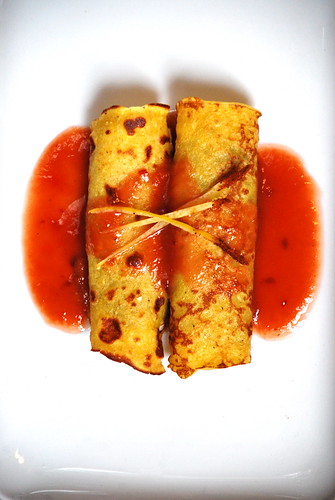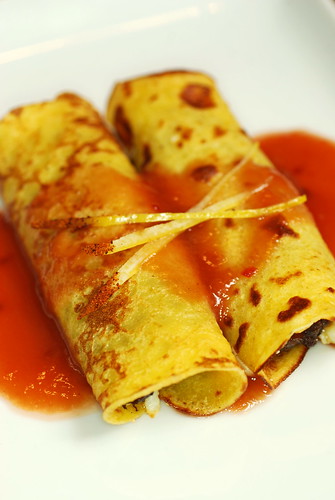This dish was inspired by two dishes that I loved to get on road trips when I was kid and as a teenager. They can be found at roadside stands that might look questionable, but the food is just too amazing to pass up.
The first of the inspiring dishes is the cachapa, a pancake made from sweet yellow corn. Once cooked the pancakes get slathered with butter and topped with Queso Blanco, the ubiquitous fresh white cheese that gets put on nearly all Venezuelan food. (In Colombia, they have a very similar dish called arepas de chocolo.) Cachapas are the perfect thing to eat after a late night out. Every now and again I get overwhelming cravings for them, and when I visit my family at Christmas in Florida, it’s one of the things I’ll seek out at least once a trip at the Venezuelan panaderias that have sprung up all over South Florida in recent years. I find its mixture of sweet and savory flavors irresistible.
The second dish is tajadas – also sometimes called maduros or plátanos fritos. These are the fried plantain slices that are served all over Latin America. They’re often served as a side dish or appetizer for a larger meal, but at the roadside stands they’re served on paper plates and covered with more of that queso blanco.
For this dish, I wanted to combine the two sets of flavors into one presentation. Initially, I tried using the cachapa in its original form, but they proved too thick and rigid to mold. Eventually, I settled on turning the batter into a crêpe batter, and after a few tries I got the right consistency.
For the filling, I wanted to use the caramelized flavor of the fried plantains. My mom always told me that really, really over-ripe plantains make the best tajadas. If you wait for the plantain to get super dark – so dark you question whether you really should be using them – the resulting tajadas caramelize beautifully on the outside from the concentrated sugars, and the inside texture becomes nice and soft. Given this soft texture, it proved really easy to break down the tajadas into a compote.
The whole dish gets topped with a tangy and spicy guava sauce to perk up all the flavors.
Wine Pairing: 2010 Willi Haag Kabinett Brauneberger Juffer Riesling.
The tropical fruit flavors in this wine complemented the fruit flavors in the dish. It also had a nice acidity and wasn’t overly sweet, which worked well the savory elements of the dish. Overall, the wine and food brought out the tangy elements in each other.
Thanks to my friend Anto and her mom for being my consultants on this dish.
INGREDIENTS
Yield: 8 servings
For the Cachapas Crêpes
Makes 16-18 small crêpes, serve two crêpes per portion
(Referenced recipe on the package of P.A.N. mix and crêpe recipe from FCI Level 2 course book.)
180 g (6 oz) P.A.N. sweet corn mix
57 g (2 oz) all-purpose flour
250 ml (8 oz) milk
180 ml (6 oz) water
4 eggs
1 tsp cooking oil
salt, to taste
60 g (2 oz) butter, or as needed to pan-fry crêpes
For the Plantain Compote
2 over-ripe plantains
250 ml (8 oz) cooking oil, or as needed to fry plantains
water, as needed
For the Spicy Guava Sauce
1 L (34 oz) Guava Nectar
juice of half a lemon
pinch of chili powder
pinch of red pepper flakes
pinch of salt
For Finish
230 g (8 oz) Queso Blanco, grated (any semi-firm fresh white cheese can be substituted)
For Garnish
Peel of one lemon
1 tsp sugar
Pinch of Chili powder
PROCEDURES
For the Cachapas Crêpe
1. Add sweet corn mix, flour, and pinch of salt to a bowl and mix together.
2. Add the dry ingredients, milk, eggs, and oil to a blender and process. Begin to the add water slowly, stopping when the mixture is smooth and reaches the consistency of crêpe batter.
3. Allow the batter to rest for at least 6 minutes.
4. Heat a crêpe pan and add butter.
5. Add a small amount of batter to pan and tilt the pan to spread the batter evenly to create a thin crêpe, approximately 5 cm in diameter. Cook over medium heat.
6. Flip and cook the second side.
7. Transfer the crêpe to a sheet pan to cool. Continue to repeat the process with the rest of the batter.
For the Plantain Compote
1. Peel and cut plantains into slices on the bias.
2. Heat oil in a heavy bottomed pan. The oil should come halfway up the plantain slices. Add plantain slices, being careful not to over crowd the pan, cooking in batches if necessary. Cook the plantains until caramelized, then flip and repeat on second side. Transfer to tray lined with paper towels to drain off excess oil. Continue to cook plantains in batches.
3. Cut up the plantain slices into pieces, then mash up a bit with a fork.
4. Transfer to a small saucepan and add a little water. Cook over medium heat, stirring with wooden spoon, until the plantains break down and form a chunky compote. Add water as needed. Hold warm for service.
For the Spicy Guava Sauce
1. Heat the guava nectar in a saucepan and allow it to reduce by about two-thirds or until nappant.
2. Stir in lemon juice, chili powder, salt, and red pepper flakes. Adjust seasoning to taste.
3. Hold warm for service.
For the Garnish
1. Julienne lemon peel.
2. Blanch lemon peel in boiling water. Repeat two more times then lay out on paper towels to drain.
3. Sprinkle the strips very lightly with sugar. (The lemon peel strips shouldn’t be candied, just slightly sweetened.)
4. Dip one end of the strips in chili powder. Set aside to allow the strips to finish drying.
To Finish for Service
1. Preheat oven to 350° F/180°C.
2. Lay out the crêpes and spoon a light layer of the compote over the crêpes. Sprinkle with the grated queso blanco.
3. Carefully roll the crêpes and place on a sheet tray.
4. Once all crêpes are rolled, transfer the sheet tray to the oven to warm and allow the cheese to melt. Once the cheese is melted, pull the crêpes from the oven.
5. Place two crêpes in the center of a plate.
6. Spoon spicy guava sauce across the top of the crêpes and allow to pool on the sides.
7. Top with lemon peel strips.















No comments:
Post a Comment